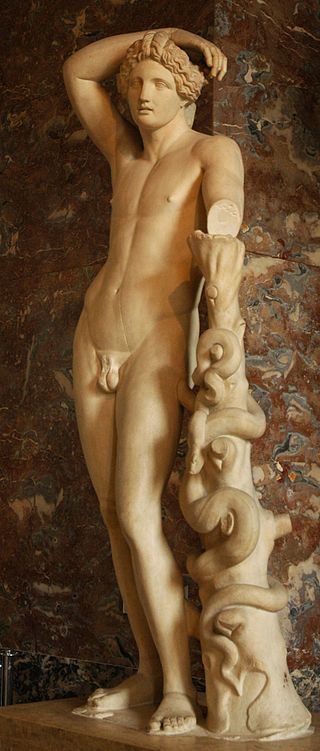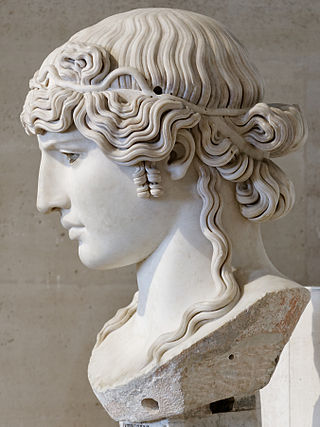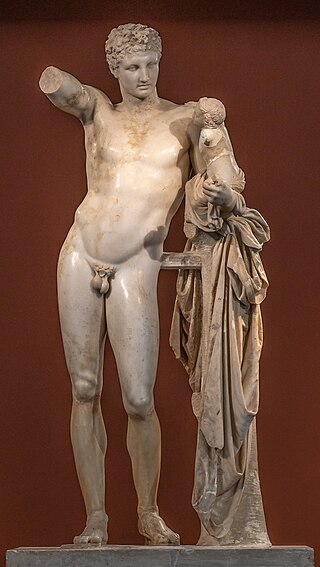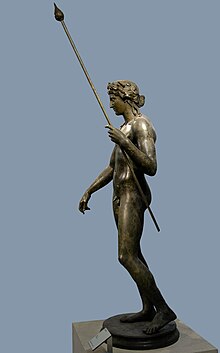
Praxiteles of Athens, the son of Cephisodotus the Elder, was the most renowned of the Attica sculptors of the 4th century BC. He was the first to sculpt the nude female form in a life-size statue. While no indubitably attributable sculpture by Praxiteles is extant, numerous copies of his works have survived; several authors, including Pliny the Elder, wrote of his works; and coins engraved with silhouettes of his various famous statuary types from the period still exist.

The Apollo Lyceus type, also known as Lycean Apollo, originating with Praxiteles and known from many full-size statue and figurine copies as well as from 1st century BCE Athenian coinage, is a statue type of Apollo showing the god resting on a support, his right forearm touching the top of his head and his hair fixed in braids on the top of a head in a haircut typical of childhood. It is called "Lycean" not after Lycia itself, but after its identification with a lost work described, though not attributed to a sculptor, by Lucian as being on show in the Lyceum, one of the gymnasia of Athens. According to Lucian, the god leaning on a support with his bow in his left hand and his right resting on his head is shown "as if resting after long effort." Its main exemplar is the Apollino in Florence or Apollo Medici, in the Uffizi, Florence.

The sculpture of ancient Greece is the main surviving type of fine ancient Greek art as, with the exception of painted ancient Greek pottery, almost no ancient Greek painting survives. Modern scholarship identifies three major stages in monumental sculpture in bronze and stone: the Archaic, Classical (480–323) and Hellenistic. At all periods there were great numbers of Greek terracotta figurines and small sculptures in metal and other materials.

Classical sculpture refers generally to sculpture from Ancient Greece and Ancient Rome, as well as the Hellenized and Romanized civilizations under their rule or influence, from about 500 BC to around 200 AD. It may also refer more precisely a period within Ancient Greek sculpture from around 500 BC to the onset of the Hellenistic style around 323 BC, in this case usually given a capital "C". The term "classical" is also widely used for a stylistic tendency in later sculpture, not restricted to works in a Neoclassical or classical style.

The study of Roman sculpture is complicated by its relation to Greek sculpture. Many examples of even the most famous Greek sculptures, such as the Apollo Belvedere and Barberini Faun, are known only from Roman Imperial or Hellenistic "copies". At one time, this imitation was taken by art historians as indicating a narrowness of the Roman artistic imagination, but, in the late 20th century, Roman art began to be reevaluated on its own terms: some impressions of the nature of Greek sculpture may in fact be based on Roman artistry.

The National Roman Museum is a museum, with several branches in separate buildings throughout the city of Rome, Italy. It shows exhibits from the pre- and early history of Rome, with a focus on archaeological findings from the period of Ancient Rome.

The Antinous Mondragone is a 0.95-metre high marble example of the Mondragone type of the deified Antinous. This colossal head was made sometime in the period between 130 AD to 138 AD and then is believed to have been rediscovered in the early 18th century, near the ruined Roman city, Tusculum. After its rediscovery, it was housed at the Villa Mondragone as a part of the Borghese collection, and in 1807, it was sold to Napoleon Bonaparte; it is now housed in the Louvre in Paris, France.

The Temple of Apollo Palatinus, sometimes called the Temple of Actian Apollo, was a temple of the god Apollo in Rome, constructed on the Palatine Hill on the initiative of Augustus between 36 and 28 BCE. It was the first temple to Apollo within the city's ceremonial boundaries, and the second of four temples constructed by Augustus. According to tradition, the site for the temple was chosen when it was struck by lightning, which was interpreted as a divine portent. Augustan writers situated the temple next to Augustus's personal residence, which has been controversially identified as the structure known as the domus Augusti.

The Temple of Apollo, also known as Apollonion, was a major part of the Panhellenic religious sanctuary located in Central Greece at Delphi. The temple and sanctuary at large were dedicated to one of the major Greek deities, Apollo, the god of archery, music, light, prophecy, the arts, and healing. There have been several temples built at Delphi throughout the history of the site, though the visible ruins seen in modernity are those of the temple built in the 4th century B.C.E. before its destruction under the orders of Theodosius I in 390 C.E.. During antiquity, the temple was home to the famous Greek prophetess the Pythia, or the Oracle of Delphi, making the Temple of Apollo and the sanctuary at Delphi a major Panhellenic religious site as early as the 8th century B.C.E., and a place of great importance at many different periods of ancient Greek history. References to Delphi, the sanctuary, the temple, and the prophecies of the Pythia are made throughout ancient Greek mythology and historical accounts from the periods of its use.

The Choiseul-Gouffier Apollo is a lifesize marble statue formerly in the collection of the comte Marie-Gabriel-Florent-Auguste de Choiseul-Gouffier (1752–1817), member of the Académie Française and French ambassador to the Sublime Porte from 1784 until the fall of the monarchy. It is now conserved in the British Museum.

The Antinous Farnese is a marble sculptural representation of Antinous that was sculpted between 130 and 137 CE. Antinous was the lover to Roman Emperor Hadrian; the emperor who, after Antinous's death, perpetuated the image of Antinous as a Roman god within the Roman empire. This sculpture is a part of the Roman Imperial style and was sculpted during a revival of Greek culture, initiated by Hadrian's philhellenism. Its found spot and provenance are unknown, but this sculpture is currently a part of the Farnese Collection in the Naples National Archaeological Museum.

Delphi Archaeological museum is one of the principal museums of Greece and one of the most visited. It is operated by the Greek Ministry of Culture. Founded in 1903, it has been rearranged several times and houses the discoveries made at the Panhellenic sanctuary of Delphi, which date from the Late Helladic (Mycenean) period to the early Byzantine era.

The Archaeological Museum of Olympia is one of the principal museums of Greece, located in Olympia. It is overseen by the Ministry of Culture and Sports, and, as of 2009, is directed by Georgia Xatzi. When the original building was completed and opened in 1888, it was the first museum in Greece outside of Athens.

In the burial practices of ancient Rome and Roman funerary art, marble and limestone sarcophagi elaborately carved in relief were characteristic of elite inhumation burials from the 2nd to the 4th centuries AD. At least 10,000 Roman sarcophagi have survived, with fragments possibly representing as many as 20,000. Although mythological scenes have been quite widely studied, sarcophagus relief has been called the "richest single source of Roman iconography," and may also depict the deceased's occupation or life course, military scenes, and other subject matter. The same workshops produced sarcophagi with Jewish or Christian imagery. Early Christian sarcophagi produced from the late 3rd century onwards, represent the earliest form of large Christian sculpture, and are important for the study of Early Christian art.

Hermes and the Infant Dionysus, also known as the Hermes of Praxiteles or the Hermes of Olympia is an ancient Greek sculpture of Hermes and the infant Dionysus discovered in 1877 in the ruins of the Temple of Hera, Olympia, in Greece. It is displayed at the Archaeological Museum of Olympia.

The Resting Satyr or Leaning Satyr, also known as the Satyr anapauomenos is a statue type generally attributed to the ancient Greek sculptor Praxiteles. Some 115 examples of the type are known, of which the best known is in the Capitoline Museums.

The Tiber Apollo is an over lifesize marble sculpture of Apollo, a Hadrianic or Antonine Roman marble copy after a bronze Greek original of about 450 BCE. Dredged from the bed of the Tiber in Rome, in making piers for the Ponte Garibaldi.

Piraeus Artemis refers to two bronze statues of Artemis excavated in Piraeus, Athens in 1959, along with a large theatrical mask and three pieces of marble sculptures. Two other statues were found in the buried cache as well: a larger-than-lifesize bronze Late Archaic Apollo and a similarly sized bronze fourth century-style Athena. Both statues are now exhibited in the Archaeological Museum of Piraeus in Athens.

The Old Drunkard is a female seated statue from the Hellenistic period, which survives in two Roman marble copies. The original was probably also made of marble. This genre sculpture is notable for its stark realism.

The Apollo Omphalos is an ancient Roman marble copy of a Greek original bronze sculpture in typical early Archaic period style, depicting Apollo, the Greek god of music, medicine, and prophecy. Today it is housed in the National Archaeological Museum of Athens, in Greece. The sculpture was found in several fragments which were put together, and bears several signs of damage.





















